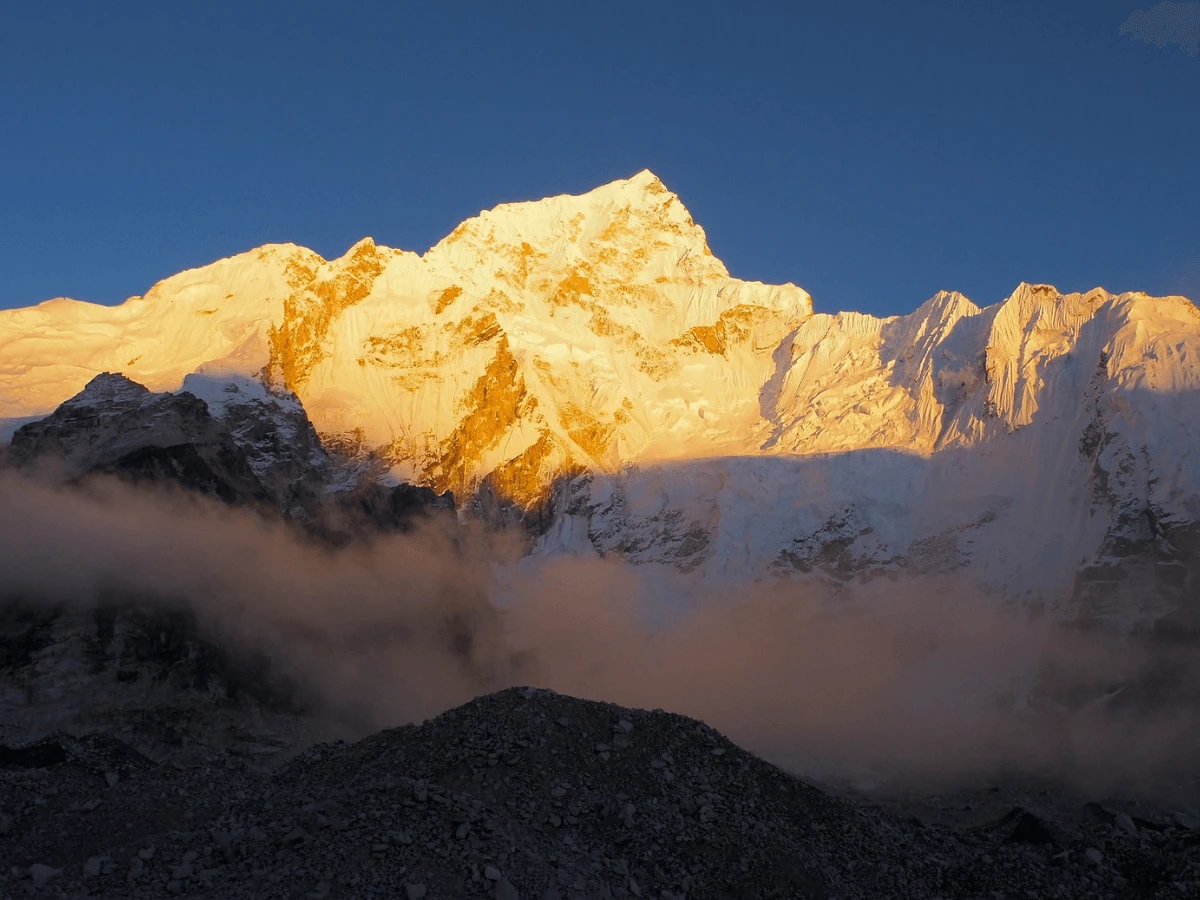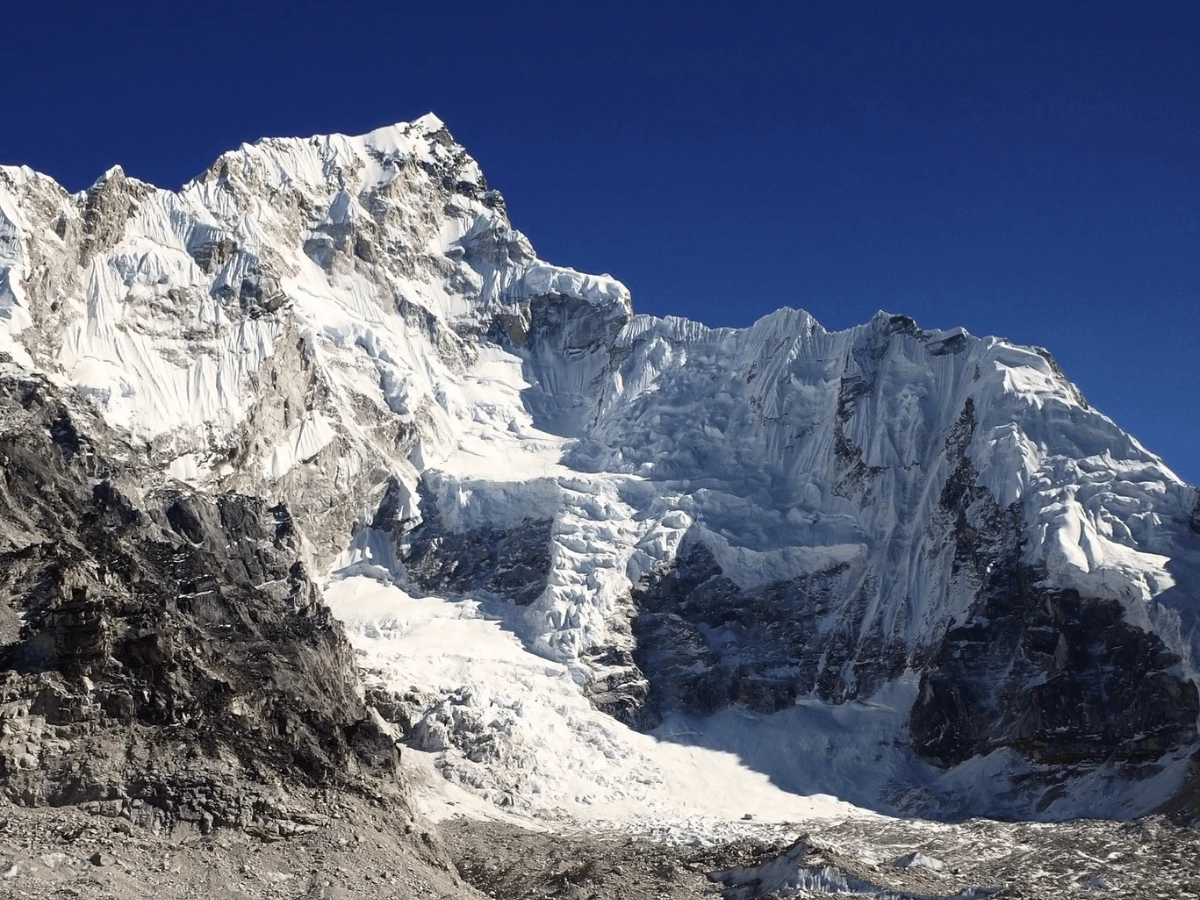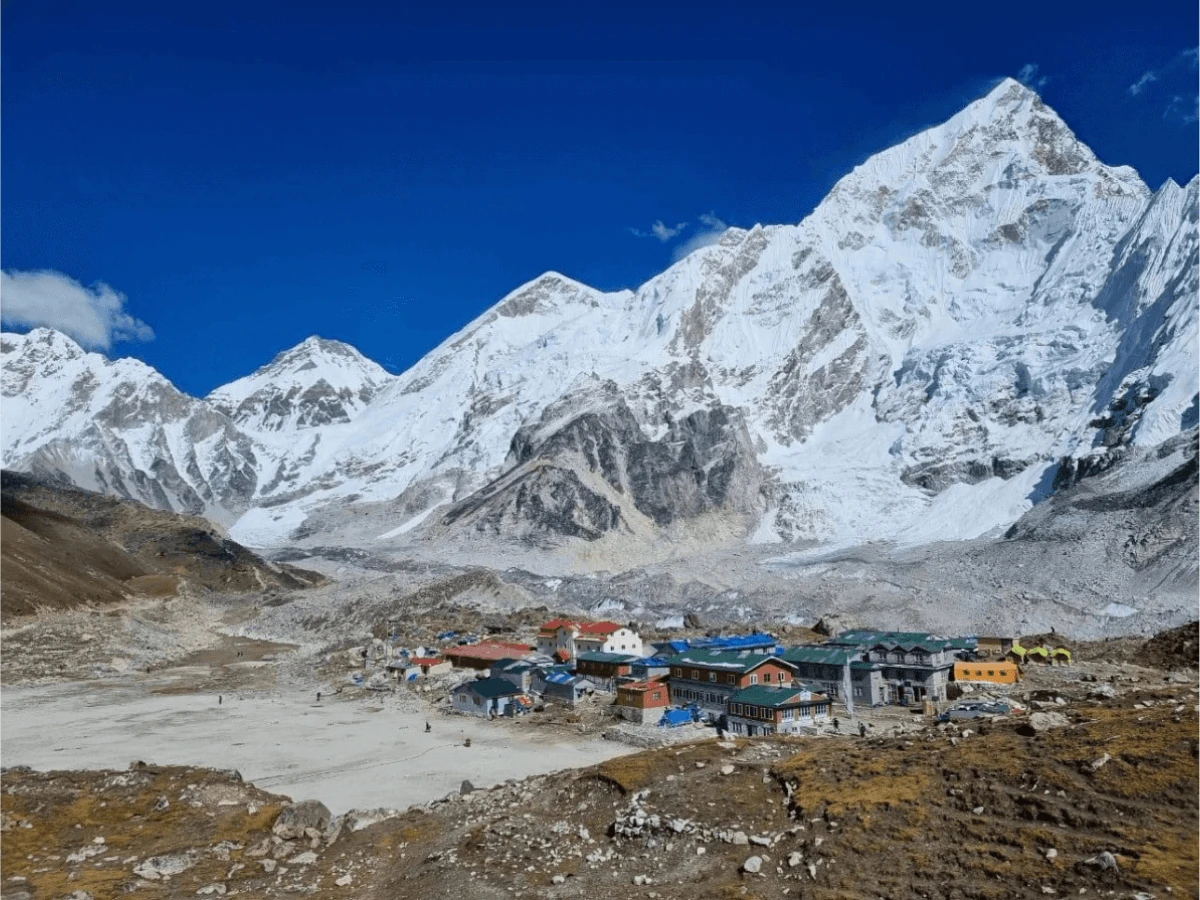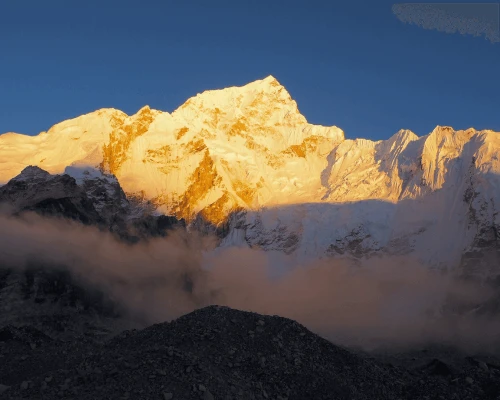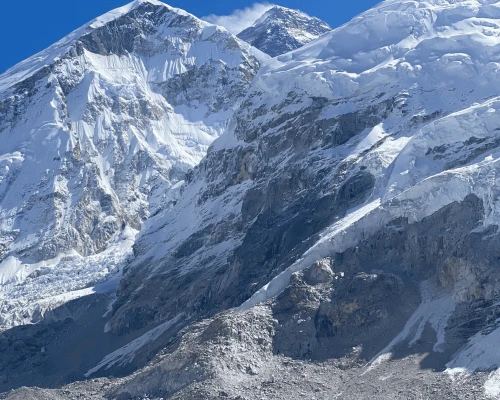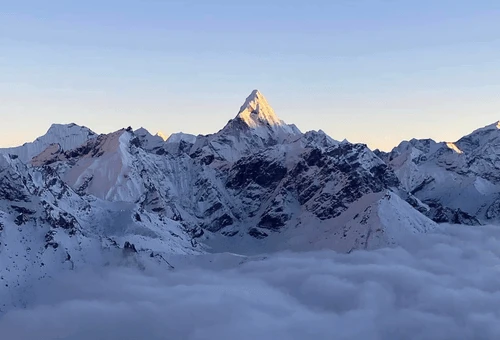Everest Base Camp Trek 14 Days is a classic two-week Himalayan trek through Nepal’s famous Khumbu region. This trek takes you from the bustling city of Kathmandu to the foot of the world’s highest peak, Mount Everest. Along the 14-day Everest Base Camp route, you will fly into the tiny mountain airstrip of Lukla and hike through picturesque Sherpa villages, rhododendron forests, and high alpine valleys.
The journey ends at Everest Base Camp (5,364 meters), where you stand face-to-face with the Khumbu Icefall and towering peaks. Moreover, a hike to Kala Patthar (5,545 m) for a sunrise view of Everest, the highest point you’ll reach on the trek.
This 14-day Everest Base Camp trek itinerary is designed with enough acclimatisation days, suitable for both beginners and experienced trekkers. The trek is challenging but rewarding at the same time. The Everest Base Camp trek difficulty is rated moderate to strenuous due to the high altitude. However, with the right preparation, both beginner and experienced trekkers can complete this Everest Base Camp Trek in 14 Days.
The highlights of the Everest trek 14 Days include the thrilling flight to Lukla, panoramic views of Himalayan giants like Mount Everest, Lhotse, and Ama Dablam, visits to ancient monasteries (such as Tengboche Monastery) and Sherpa museums, and the sense of accomplishment of standing at Everest Base Camp. The trek truly offers an unforgettable blend of natural beauty, cultural insight, and personal achievement.
Typical Day During the Everest Base Camp Trek 14 Days
On a typical trekking day, expect to walk around 5 to 7 hours in total, covering 8–15 km depending on the section of the Everest Trek route. Some days involve steep uphill climbs or long descents, while acclimatisation days entail shorter hikes to higher elevations and back.
A day on the Everest Base Camp trek is both strenuous and rewarding: you’ll be surrounded by inspiring mountain scenery and friendly faces from sunrise to sunset. Despite the physical effort, the supportive atmosphere and sense of adventure keep you motivated each day. Right from the moment you hike from Namche, you will start to see the views of Mount Everest, Ama Dablam, Lhotse, Khumbila, and many more during the daytime.
Note: The usual days begin around 7:30 in the morning after breakfast, Lunch time will be around 1-2 pm, and dinner is served between 6-7 pm.
Is the 14-Day Everest Base Camp Trek Suitable for Beginners?
Is the 14-Day Everest Base Camp Trek suitable for beginners? In short, yes – beginners can absolutely do the Everest Base Camp Trek in 14 days, as long as you prepare properly.
The Everest Base Camp trek difficulty level is categorised as moderate. Many first-time trekkers have completed this journey successfully. The main challenge is the high altitude and endurance required for multiple days of hiking. As a beginner, you should be in good physical shape and willing to train before doing the EBC Trek.
Altitude is the big equaliser on this trek; even very fit people can feel the effects of thin air above 3,500 m. That’s why our 14-day itinerary includes two acclimatisation days (at Namche Bazaar and Dingboche) to help your body adjust to the Everest Base Camp altitude & acclimatisation process. With enough time to acclimate, a beginner trekker can handle the daily hiking distances. Everest Base Camp trek difficulty for a beginner mostly comes down to mental determination. If you’ve never done a high-altitude trek before, the EBC trek will certainly test you – but that’s part of the adventure!
To ease into trekking, some newcomers choose to do a shorter trek first, like the Langtang Valley Trek or Annapurna Base Camp Trek. Doing a shorter trek can build your confidence. However, if you’re set on Everest Base Camp, it’s definitely achievable for beginners who commit to training and perhaps trek with an experienced guide.
At Mountain Eco Trails, we’ve guided many first-time trekkers to Everest Base Camp, and we ensure everyone goes at a comfortable pace. In summary, the 14-Day Everest Base Camp Trek is doable for beginners – you don’t have to be a super athlete, but you should prepare physically, take altitude seriously, and trek with proper support.
(Tip: If you’re a beginner or short on time, consider the shorter Everest View Trek as an introductory option. It’s a great way to experience Sherpa culture and see Everest from viewpoints like Tengboche without the longer commitment.)
Short Outline Itinerary of 14-Day Everest Base Camp Trek
Here is a short outline of the Everest Base Camp trek itinerary (14 days):
- Day 1: Arrival in Kathmandu (1,400m) – Meet our team, trip briefing and trek preparation.
- Day 2: Fly to Lukla (2,860m) and trek to Phakding (2,610m) – 35 min flight & 3-4 hours trek.
- Day 3: Trek from Phakding to Namche Bazaar (3,440m) – 6 hours trek, enter Sagarmatha National Park at Monjo.
- Day 4: Acclimatisation day in Namche Bazaar – Short hikes to Everest View Hotel (3,880m) or Khumjung village; overnight in Namche.
- Day 5: Trek from Namche to Tengboche (3,860m), 5-hour trek. Visit Tengboche Monastery with its panoramic view of Everest and Ama Dablam.
- Day 6: Trek Tengboche to Dingboche (4,410m), 5-hour trek, passing Pangboche and many Mani stone walls.
- Day 7: Acclimatisation day in Dingboche – Optional hike to Nangkartshang Hill (5,100m) for acclimatisation and superb views of Makalu, then return to Dingboche to rest.
- Day 8: Trek Dingboche to Lobuche (4,940m), 5–6 hours trek. The trail ascends past Thukla Pass (where there are memorials for climbers) and continues to the small settlement of Lobuche near the Khumbu Glacier.
- Day 9: Trek from Lobuche to Gorak Shep (5,170m), visit Everest Base Camp (5,364m), 7-8 hours total trekking. Reach Gorak Shep for lunch, then hike to Everest Base Camp in the afternoon, celebrate and take photos, and return to Gorak Shep for the night.
- Day 10: Hike to Kala Patthar (5,545m) & descend to Pheriche (4,280m) – Pre-dawn climb of Kala Patthar for sunrise on Everest (this is the highest point of the trek). Descend back to Gorak Shep for breakfast, then continue down via Lobuche and Thukla to Pheriche. (8+ hours day, but mostly downhill).
- Day 11: Trek Pheriche to Namche Bazaar – ~6–7 hours trek retracing the route through Pangboche and Tengboche, then down to the hustle and bustle of Namche.
- Day 12: Trek from Namche Bazaar to Lukla – ~6–8 hours trek. A long descent to the Dudh Koshi River and final climb to Lukla. In the evening, enjoy a farewell dinner with your trek crew in Lukla.
- Day 13: Fly from Lukla back to Kathmandu – 30-minute scenic flight in the morning (weather permitting). Transfer to your hotel and enjoy a free day in Kathmandu to relax or do some city sightseeing.
- Day 14: Departure from Kathmandu – Trip concludes. Say goodbye to Nepal or continue your travel plans.
(Note: It’s wise to allow an extra buffer day or two in your schedule in case of Lukla flight delays due to weather. Our 14-day plan is usually smooth, but mountain weather can be unpredictable.)
This outline gives a quick overview of the 14-day Everest Base Camp route, including two acclimatisation days and all the key stops. The itinerary is carefully designed to balance daily trekking distance with proper altitude acclimatisation, increasing the chances of a safe and enjoyable journey to Everest Base Camp.
14-Day Everest Base Camp Trek Cost, 2026, 2027
One of the first questions many trekkers have is: What is the Everest Base Camp trek cost for 14 days? The cost of the 14-day Everest Base Camp trek can vary widely depending on the level of service, inclusions, and itinerary. As of now, Mountain Eco Trail offers a typical 14-day guided Everest Base Camp Trek package for around USD $1,600 to $2000 per person. This usually includes your round-trip flight to Lukla, permits, accommodations, guide services, and meals on the trek.
Why choose Mountain Eco Trails for the trek to the Everest Base Camp?
Choosing the right trekking company can make a huge difference in your experience. Mountain Eco Trails specialises in Everest and other Nepal treks, providing a balance of safety, professionalism, and local expertise. Here are a few reasons to trek with Mountain Eco Trails:
- Experienced crew members and official team.
- Flexible and customised Langtang Trek Itinerary with personalised service.
- Complimentary Services like Duffel Bag, Trekking Poles, SIM Card, and an hour trekker's massage
- First Aid Kit with basic medication.
- Hassle-free last-minute booking and trip arrangements.
- Competitive and Fair price that matches the services and has no hidden costs.
- Special Discount for a group of trekkers of more than 5 Pax.
With Mountain Eco Trails, you trek with a trusted local company that prioritises your experience, safety, and the environment. We strive to turn your Langtang journey into an incredible memory you’ll cherish for life. If you need more information regarding the trek, feel free to contact us via email or WhatsApp us at +9779849790153.

